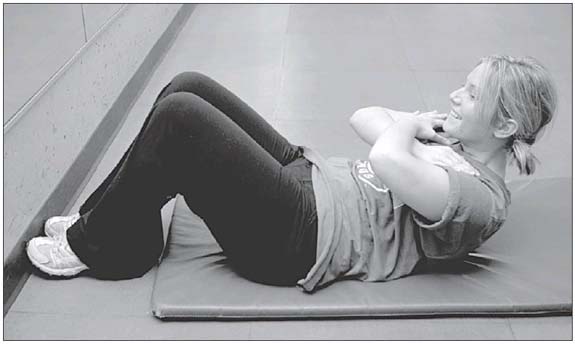|
Don't bust your gut
There's no easy way to reduce belly fat. It takes exercise, a healthy diet and time - a lot of it - to dissolve that jelly
JILL BARKER, The Gazette, September 23, 2008
|
Karen Spilak works on curl-ups: all waistlines expand with age and no single exercise will solve the problem.
Photos by Marie-France Coallier, The Gazette
|
Despite claims made on the cover of popular fitness magazines, there is no quick and easy way to get rid of excess belly fat.
So before you embark on a gut-busting fitness program in an attempt to whittle away everything that hangs over your belt buckle, consider the real facts behind achieving abs worthy of gracing a magazine cover.
First a reality check. Despite a healthy diet and lots of exercise, all waistlines expand with age. That being said, diet and exercise are still the key to keeping that inevitable expansion to a minimum. And, as an added bonus, an active lifestyle can help keep belly fat from harming your health.
Why is getting rid of belly fat so important? Two reasons. If you want to show off your belly, you've got to get rid of the fat that's covering your abs of steel. And, since excess belly fat is associated with increased health risks, losing inches around the waist is a must if you want to fight off chronic illnesses like diabetes and heart disease.
How much exercise does it take to get rid of a jelly belly? There is no one standard that is guaranteed to do the job, but a couple of studies done by Paul Williams of University of California Berkeley give us an idea of the kind of sweat equity that is needed to keep the waistline in check.
|
| Work your abs the way they work in real life: as part of a team of muscles. |
In a study of over 60,000 male runners Williams discovered that all men, even those who chalked up lots of running miles, gained girth around the middle as they aged. Those who gained the least, however, continued to increase their weekly mileage by about two kilometres every five years. At first glance, the added volume doesn't seem like much, but if you add up the five-year increments, the numbers are significant. According to Williams, a man who runs 16 kilometres a week at age 25 needs to increase his running distance to 64 kilometres a week by age 50 to maintain his waistline.
Women, on the other hand, are a bit different. Williams performed a similar study on 40,000 female runners who, unlike men, weren't doomed to put on inches around the waist as they approached middle age. In fact, until the age of 45 women who ran as little as eight kilometres a week managed to maintain their waistline and those who ran 40 kilometres a week actually whittled away at their belly.
After 45 however, the magic effect of exercise wore off, and the belly started to slowly increase regardless of running distance.
Are other forms of aerobic exercise just as effective at reining in belly flab? Probably, but like the running studies demonstrated, you can't let your exercise habit slide over time if you want to ward off unwanted inches. In fact, you need to sweat more, not less, as you age.
If all that aerobic exercise scares you off, is the age-old belly-off method of performing lots of sit-ups a viable alternative?
To date, there are no data suggesting that sit-ups, curl-ups or any other single exercise or series of exercises have any effect on your goal of achieving a six-pack. Besides, exercises that target your abs don't preferentially burn the fat that accumulates around your waist. And, as far as getting your belly in shape, according to Dave Campbell, osteopath and athletic trainer at Concordia Sports Medicine, sit-ups aren't all they are cracked up to be.
He suggests working your abs they way they work in real life; as part of a team of muscles - not in isolation. Therefore, exercises that train the hips, legs, back, abs and other trunk muscles synergistically are better choices (try a walking lunge combined with an overhead press) than sit-ups or curl-ups, which quite frankly are only good at improving your ability to do more sit-ups and curl-ups, not create a six pack.
Campbell also suggests training the abs for endurance before improving their strength. That means performing stability exercises like the plank, which train your abs to keep your torso strong and upright while sitting, standing and playing sports.
If exercise still isn't your thing, how about dieting as a way to melt belly fat?
A study led by Bob Ross of Queen's University looked at three ways to shrink your waistline; diet only, diet and aerobic exercise and diet and resistance exercise. All three resulted in lost inches everywhere on the body, but the combination of diet and exercise (aerobic or resistance training) seemed to target belly fat better than the diet-only option.
So there you have it. It is possible to lose your gut, but it takes more than just a few minutes of exercise a day. In fact, getting rid of belly fat demands a lifetime commitment to eating healthy and exercising regularly.
[email protected]
© The Gazette (Montreal) 2008
|



